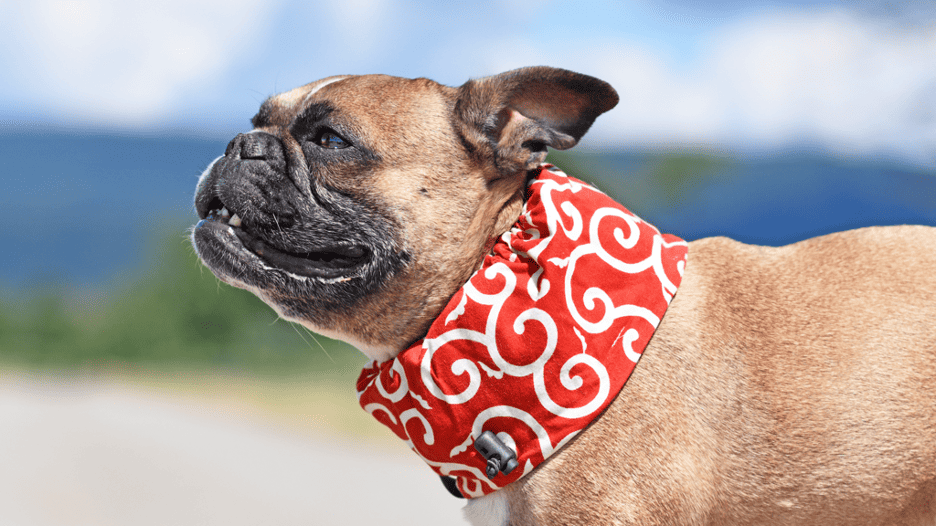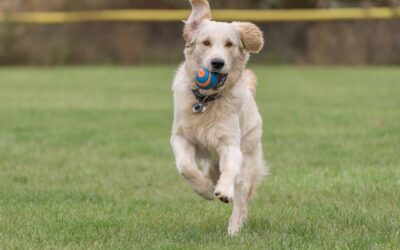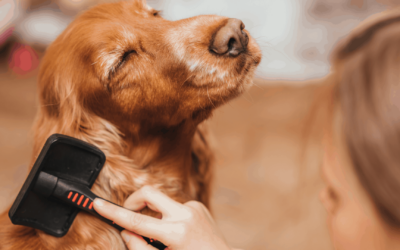Dog Overheating Symptoms, Dangers & Treatment

As dog owners, we take great pride in the well-being of our pets. However, summer months can threaten their health as dogs are susceptible to overheating. This can be a concerning problem that may result in heat exhaustion or heat stroke if left unchecked.
This comprehensive guide will explore symptoms, dangers, and treatment options available for dogs experiencing overheating and how you can take proactive measures against this threat to ensure their well-being throughout the upcoming season.
Why do Dogs Overheat?
Dogs are more prone to overheating than people are since they have limited numbers of sweat glands in their paw pads to cool themselves. When temperatures rise or they’re engaging in more physical activity than they can keep up with, their bodies struggle to distribute the heat, resulting in overheating.
You may notice that your dog pants a lot when they get hot. This is because they rely heavily on panting as their main method to cool off.
Remember that a normal body temperature for your dog will be between 99.5 and 102.5 degrees Fahrenheit. Anything outside of this range can indicate overheating. You can measure your dog’s body temperature using a rectal thermometer for the most accurate reading.
What Is Dog Heat Exhaustion (Overheating)?
Heat exhaustion in dogs, or hyperthermia, occurs when their body temperature exceeds the norm and cannot be brought down through panting alone. If this condition goes unchecked, it can become dangerous to their health. Heat exhaustion may even progress into heatstroke, causing the body’s internal systems to malfunction and shut down completely.
What Are the Signs of Dogs Overheating?
Recognizing the signs of overheated dogs is crucial in protecting your pet from serious health risks. Understanding their symptoms will cue you in to immediately cool them off and avoid further complications. Here are some of the most common symptoms of dogs overheating:
- Excessive panting or difficulty breathing: When overheated, dogs often pant heavily and exhibit rapid or shallow breathing patterns, making it hard for them to catch their breath. Panting for up to 10 minutes is normal for healthy dogs after exercise. If your pup is still panting excessively after this time, you should seek medical attention.
- Dehydration: Overheated dogs may show signs of dehydration, which can be identified by dry gums and increased thirst.
- Excessive Drooling: Dogs experiencing overheating may drool excessively as their body attempts to cool itself down.
- Fever: If your dog has a fever, it may be a telltale sign that they’re overheating. Use a thermometer to check their temperature yourself or visit your vet immediately to address any concerns.
- Discolored gums: Overheating can result in changes to the color of gums. Be wary of bright red, gray, purple, or bluish gums.
- Lack of urine production: If your pup has not gone for an extended period, it could indicate that they have become overheated and dehydrated. Healthy dogs urinate between 3 and 5 times per day. You’ll know something is wrong if your pup goes less frequently or produces smaller amounts of urine.
- Rapid Pulse (Fast and Irregular Heartbeat): Overheated dogs may exhibit an elevated heart rate. To check this, place your hand behind their elbow to take their pulse. An elevated heart rate (in beats per minute) is 160 bpm for standard sized dogs, 140 bpm for large dogs, and 180 bpm for toy breeds. Puppies’ hearts beat more rapidly than adult dogs, so 220 bpm is considered an elevated heart rate during this stage.
- Tremors/Muscle Spasms: Closely monitor any tremors or muscle spasms, as these are indicators your dog may be overheating.
- Lethargy or Weakness: Overheated dogs may appear lethargic and weak, lacking energy or enthusiasm. This is different from usual lounging or napping – you’ll know if your pup is weak and lethargic if they’re sleeping longer than usual or appear wobbly. They may also have trouble standing up or walking. Look out for other symptoms, like diarrhea and vomiting, that may indicate something is wrong.
- Vomiting or Diarrhea: Due to overheating, digestive disturbances may arise, causing vomiting or diarrhea from excessive heat exposure.
- Dizziness: Overheated dogs may appear disoriented or have difficulty maintaining their balance.
Dog Breeds that Overheat Easily
Some dog breeds experience overheating more often than others. This particularly applies to flat-faced dog breeds that have brachycephalic genes.
Some examples include:
- Bulldogs
- Pugs
- Boston Terriers
- Shih Tzus
- French Bulldogs
They lack airways that easily regulate body temperature effectively when compared to thick-coated breeds such as Huskies or Malamutes. For these types of dogs, regulating body temperature is difficult despite efforts at controlling body temperature effectively. If your pet is included in this group, extra care must be taken during hot weather to prevent overheating.
Additionally, dogs with a genetic predisposition to exercise-induced collapse (EIC) need to be careful about overheating. High temperatures can worsen EIC and may put your pet at higher risk for heatstroke. This includes retrievers and spaniels.
How to Keep Your Dog from Heat Exhaustion (Overheating)?
Preventing dogs from overheating is key to their well-being. By following some of these tips, you can dramatically decrease the risk of heat-related illnesses in your pet:
- Give them a break: Make sure your dog has access to a shady area where they can take a break from the sun. This can be a covered porch, access to a ventilated room through a doggy door, or another shaded spot in your backyard like a doghouse.
- Avoid exercise during peak heat: Avoid engaging in rigorous physical activity with your dog during the hottest parts of the day, such as noon walks. Instead, opt for early or late evening strolls when temperatures are typically more pleasant. Healthy dogs can generally handle 15-30 minute walks in normal conditions, but this changes when temperatures rise. Heat stroke can occur within just 15 minutes, so avoiding exercise in the heat altogether is best. As a general guideline, stay away from temperatures higher than 77 degrees Fahrenheit when planning to walk your dog long distances or go on a hike.
- Proper hydration: Ensuring your dog has access to enough clean water is vital in helping avoid overheating. Use a pet fountain or add some ice cubes into their water bowl to keep things cooler longer. If you’re out on walks or on the go, have a portable dog water bottle with fresh water available so your dog doesn’t have to go without water to cool them down for hours.
- Avoid hot surfaces: Asphalt and concrete surfaces can quickly become scorching hot in the summer heat. When walking your dog, opt for grassy spaces to avoid burning their paws.
- Use cooling aids: There are various cooling aids available to keep your dog’s body temperature under control, from cooling mats and bandanas to vests designed to lower body temperatures.
- Ventilate the area: Make sure your dog has sufficient airflow in the areas where they play and sleep to avoid heat build-up.
- NEVER leave dogs in parked cars: It is essential never to leave your dog unattended in a parked car, even for short periods, due to rising temperatures inside, which could be fatal.
- Try Indoor Activities: On particularly hot days, indoor activities that engage and mentally stimulate your dog, such as puzzle toys or training exercises, should be considered to help combat overheating in your pet. Indoor exercise is also a good alternative – our favorite is doggy push-ups (repeating sit, lay down, and stand-up commands).
How to Treat Dogs Overheating In an Emergency Situation?
If your dog seems to be experiencing heat exhaustion or heatstroke, immediate action must be taken to ensure its health and safety. Here’s what to do when your dog is in an overheating emergency:
- Move your dog out of the heat: Transport your pet to a shaded or air-conditioned location to reduce body temperature.
- Spray cool water: Gently mist your dog with cool (not cold) water to soothe and relax their blood vessels. Pay special attention to their head, neck, and paws, as these areas contain the highest concentrations of blood vessels. A hose, spray bottle, or wet towels may all work to cool them down quickly and effectively.
- Use a fan: Positioning a fan near your dog to dissipate heat from its body surface can help cool them down.
- Wipe their face and muzzle: For added cooling benefits, wipe their face and muzzle with a damp cloth soaked with cool water to help lower their body temperature.
- Provide small amounts of water: If your dog is aware and able to swallow, provide small amounts of cool water as a treat. Please note that attempting to force your pet to drink the water may lead to choking incidents.
- Seek Emergency Care: Even if it seems as though your dog has returned to normal, it’s still vitally important to get professional medical help for your pup immediately. Heatstroke can damage internal organs severely, and professional medical treatment should always be sought right away.
When faced with an emergency overheating situation as a dog owner, having a reliable insurance policy, such as The Illness & Injury Plan from Odie, can give you peace of mind. It averages $45 per month for dogs and covers emergency vet visits, 24/7 televet chats, overnight hospital stays, and more to help you care for your pet during such a traumatic time.
Is Overheating a Sign of Heart Problems?
Overheating may be a sign of heart problems in your dog, so it’s important to have them checked immediately when you notice the symptoms. When your dog’s heart is not functioning properly, they can overheat due to inadequate circulation and lack of oxygen in its organs. The Illness & Injury Plan provides comprehensive coverage for medical expenses related to heart conditions and overheating so your pet can get the necessary treatments.
How Do I Know If My Dog Is Panting Too Much?
Pay Attention to Your Dog’s Behavior
We spend a lot of time with our dogs, so we know what they are “normally” like. If extreme panting starts suddenly, won’t stop, or is accompanied by coughing or wheezing, you may want to take him to the vet. These vet visits are when Odie Pet Insurance can really come in handy.
Keep an Eye Out For Other Symptoms
As mentioned above, coughing or wheezing, especially when sleeping, is a cause for concern. If your dog isn’t acting like themselves, such as being lethargic, not eating or eating less, being aggressive or too passive, bloating, and vomiting are other worrisome issues. Take your dog to the vet A.S.A.P. if you suspect something is wrong.
Take Notice of Any Alterations in Your Dog’s Panting Sounds
If your dog is wheezing, panting harder, or has soft breath sounds that are uncustomary to how they normally pant, you may want to take her to the vet. Any difference at all in the way, sound, and time your dog pants are all red flags.
You can also learn more on why your dog might be panting so much by clicking here.
What Does Odie Pet Insurance Cover?
Pet insurance covers various veterinary expenses, providing financial protection and peace of mind for pet owners. Here are the details of the coverage options offered by Odie Pet Insurance:
Illness & Injury Plan
The Illness & Injury Plan is an all-inclusive insurance plan designed to cover a wide range of medical needs for your pet. This plan includes comprehensive coverage for various illnesses, injuries, and veterinary services. Some of the covered items include:
- Veterinary exams and consultations
- Diagnostics (e.g., X-rays, lab tests)
- Prescribed medications
- Surgeries and hospitalization
- Rehabilitation, acupuncture, or chiropractic treatments
- Medically necessary supplies
- Euthanasia and cremation
The Wellness Plan
The Wellness Plan is a monthly membership that focuses on preventive care and covers routine veterinary services.
- Provides reimbursements for routine care items such as wellness visits (exams and vaccines), testing and parasite prevention, dental cleanings and at-home dental care, vitamins, supplements, and more
- Through Odie’s partnership with Petivity, a leader in smart pet products and proactive care, Wellness Plan members can also receive reimbursements for Petivity devices and health kits, as well as eligible Purina food and supplements.
- Total reimbursement up to $700 per year.



